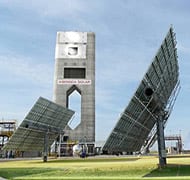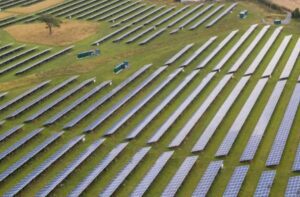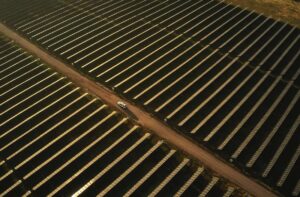One of the world’s leading developers of solar energy says that solar tower technology with storage will be competitive with baseload gas generation by 2020, and able to perform similar functions without the emissions.
Abengoa, the Spanish owned developer of a range of concentrated solar power (CSP) technologies, as well as solar PV, says the dramatic falls in capital costs, and rising efficiency levels, means that large scale CSP will be competing with combined cycle gas turbines on cost, efficiency, and utility by the end of the decade.
Abengoa last week broke ground on a 110MW molten salt storage plant, which combines solar tower technology with 18 hours of thermal energy storage based on molten salts.
The Cerro Dominador plant is being built in Chile’s Altacama Desert, the region with the high concentration of solar radiation in the world. It is the first solar-thermal plant for direct electricity production in Latin America.
CEO and chairman Manuel Sánchez Ortega said the new plant will have a capacity factor of around 80 per cent, which puts it as high as most fossil fuel generators.
“This is a significant step forward to be competitive with conventional generation,” he told analysts from the Altacama Desert in a telephone briefing for the 1st quarter results last week.
In Chile, competition with fossil fuels is already the case. Cerro Dominador will provide baseload power generation to mining operations in Chile, which pay huge costs for fossil fuel generation.
Ortega says there numerous opportunities emerging in other markets. Another round of tenders for solar thermal technology will be held in South Africa, a similar program is occuring in northern Africa and he said there is “amazing opportunities” in Mexico, which this week announced it was lifing its renewable energy target for 2020 to 33 per cent from 25 per cent.
Cerro Dominador is one of a number of ground-breaking projects that Abengoa is undertaking. This week, it opened the world’s largest solar PV plant with single-axis tracking – the 206MW Mount Signal plant in California. Last year, it opened the world’s largest CSP plant with storage facility also in California, the 260MW Solana plant that uses parabolic trough technology and has been helping meet demand peaks in the evening. It is also nearing completion of the 280MW Mojave parabolic trough plant in California.
 In South Africa, it is building a 50MW plant using its more traditional solar tower technology, while it has also unveiled a new generation large aperture trough plant at its research and demonstration facility in Spain, and has a 2MW demonstration of its so-called “superheated solar tower” technology.
In South Africa, it is building a 50MW plant using its more traditional solar tower technology, while it has also unveiled a new generation large aperture trough plant at its research and demonstration facility in Spain, and has a 2MW demonstration of its so-called “superheated solar tower” technology.
It is also about to begin construction of the 110MW Ashalim parabolic trough project in Israel, the Xina Solar One 100MW parabolic trough plant with five-hour storage in South Africa, which will be located next to the 50MW KaXu Solar One project currently under construction.
Here is Abengoa’s explanation of how the solar plant in Chile will work.
Solar-thermal tower technology uses a series of mirrors (heliostats) that track the sun on two axes, concentrating the solar radiation onto a receiver on the upper part of the tower, where the heat is transferred to the molten salts. The salts then transfer their heat to a water current in a heat exchanger that generates superheated and reheated steam, which feeds a turbine capable of generating around 110 MW of power.
The solar plant will also have a pioneering thermal storage system, designed and developed by Abengoa, which makes this technology highly manageable, enabling it to supply electricity in a stable way, 24 hours a day, responding to electricity demand at any time.
These couple of graphs explain how the technology costs are coming down, and the efficiency rising to compete with conventional generation.











